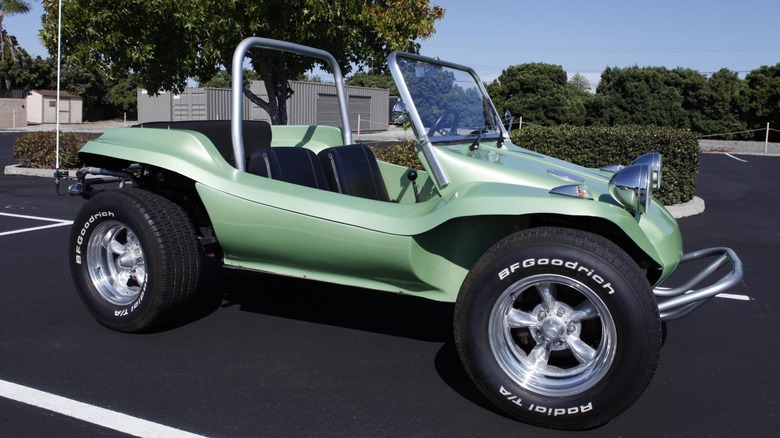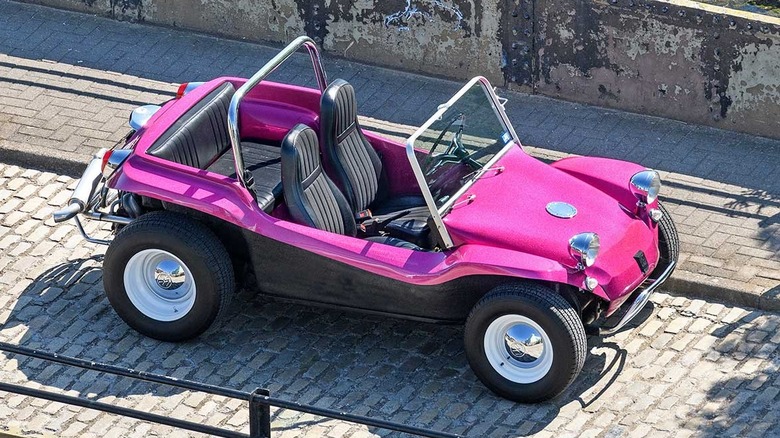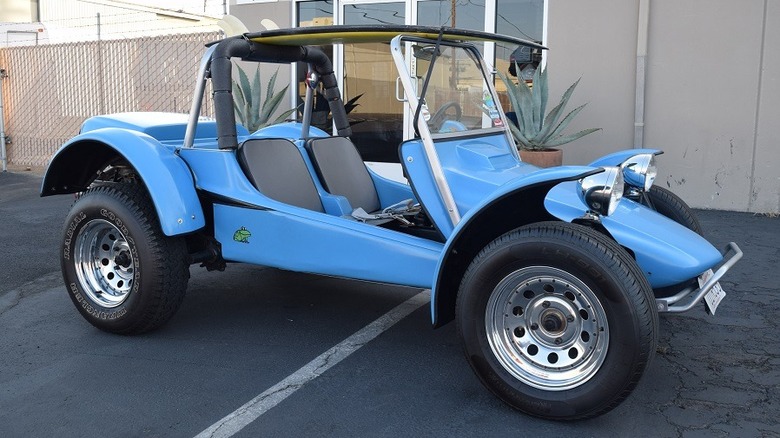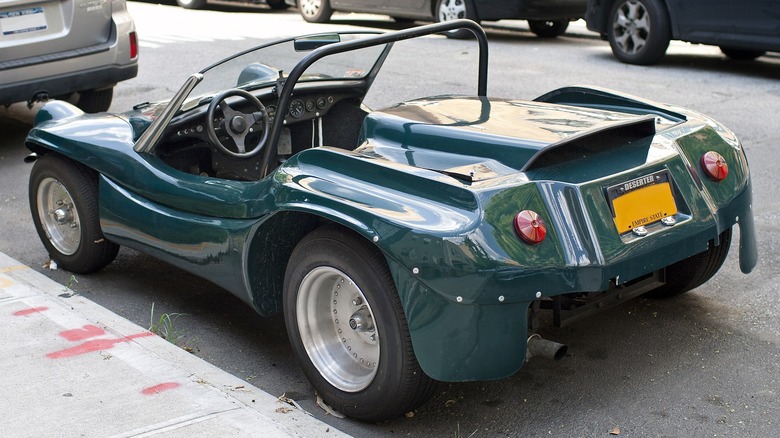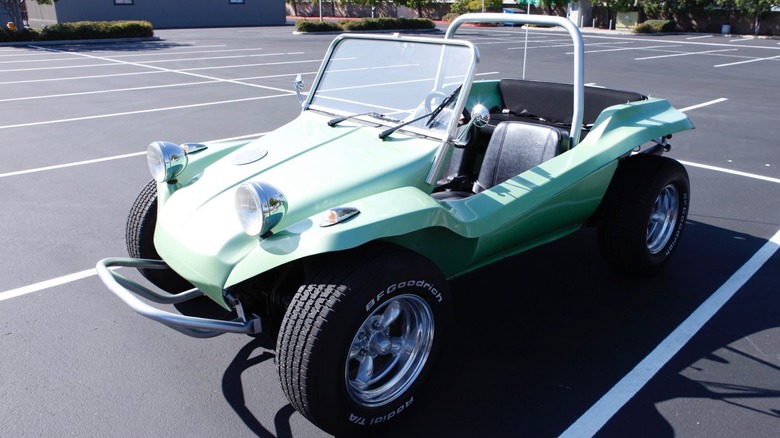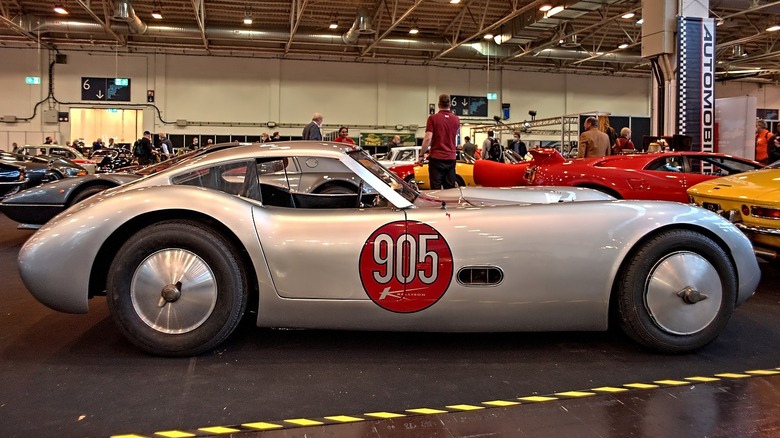5 Of The Most Desirable Dune Buggy Kit Cars For Summer Driving
In the mid-1960s, California beach and surf culture was catching on in a big way. From bands and music like "The Beach Boys," to fashion trends like the bikini, folks everywhere strived to emulate that care-free life under perpetual sunshine. That applied to cars, too: All of a sudden, a repurposed Volkswagen Beetle with a brightly colored minimalist fiberglass body became the most fun that you could have on four wheels. The world had discovered the dune buggy.
Almost all dune buggies were sold in kit form, and were relatively inexpensive to build. The starting point usually involved purchasing a Beetle which had been involved in a wreck, followed up by a visit to a local body shop to remove the old body and refit the new shell. Buyers with suitable tools and mechanical aptitude could opt to tackle the conversion process themselves — and many did.
This cheap and cheerful conversion caught on like wildfire, and by 1969, there were at least 70 companies of varying magnitude offering dune buggy kits. It's estimated that more than 250,000 kits were sold worldwide. With so many to choose from, we've compiled a list of five machines that stood out amongst a sea of metal flake gelcoats and chrome wheels.
Meyers Manx
As an engineer, boat builder, and surfer, Bruce Meyers seemed almost destined to commercialize the idea of a beach buggy. His creation was a more refined version of the custom built vehicles he witnessed roaring up and down southern California beaches — based on a modified VW Beetle frame and drivetrain. Besides recreational use, the buggy also dominated off-road races at its inception. It was named the Manx after a long-legged tailless breed of cat known for its maneuverability while chasing.
The popularity of the Meyers Manx inspired many copycat designs. Although Bruce Meyers had properly patented his invention, the patent was later rescinded in court, allowing the copycats to continue. In total, approximately 6,000 original Manx are said to have been produced.
Though shuttered since 1971, Bruce Meyers brought his namesake company back to life in the year 2000. The reinvented company was sold again in 2020, and remains operational today. Of all the dune buggies on this list, the Meyers Manx is the only brand-new buggy that you can still buy in kit form and assemble yourself.
There are improvements over vintage models, too, including a spacious locking storage compartment, and chases for wiring integrated into the body. Speaking of the body, it's available in the buyer's choice of 18 solid colors, or a whopping 46 hues of metal flake for an extra cost. According to the Meyers Manx website, the buggy kit presently starts at $5,995, and all-electric Manx 2.0 EV is also in development.
Meyers Tow'd
The Tow'd was another Meyers-designed buggy that was released shortly after the original Manx. Although the two models were loosely related, the Tow'd was not legal for street driving. While the Tow'd utilized powertrain, suspension, and steering parts from a donor VW Beetle, it did not incorporate the Beetle's chassis like the Manx.
Instead, the Tow'd featured a custom frame made from two-inch tubular steel with a unique feature: a retractable tow bar permanently integrated into the vehicle's frame. This made it simple for Tow'd owners to transport the buggy to the desert, beach, or racetrack behind another vehicle.
The Tow'd was also narrower than the Manx, with a wedge-shaped body that weighed in at a truly featherweight 900 pounds. Reportedly, some of the Tow'd buggies were fitted with six-cylinder engines from Chevy's Corvair. Combined with its light weight, this would undoubtedly make them some of the fastest machines around. They were also some of the rarest, with just 850 Tow'ds sold.
According to classic.com, Tow'd values have remained steady over the past several years, with an average selling price of $13,667.
Deserter GT/GS
Deserter dune buggies were offered up between 1969-1974 by Dearborn Automobile Company in Massachusetts — later known as Autodynamics. The Deserters were available with two body styles: one of which was the S1, a typical swoopy fiberglass configuration with no doors, windows, or roof. However, Deserter ran a cheeky ad campaign which promised "Options available for beach, swamp, snow, mountains racetrack, and turnpike."
The other body style, called the GT, checked a few of those boxes. The GT has a full fiberglass hardtop, including gullwing doors and an optional leather-look vinyl covering. The GT was no doubt born out of necessity for a company based in New England — not California — if year-round driving was desired.
As if two body styles wasn't enough, Deserters also came with a choice of two chassis. The standard model was based on the ubiquitous shortened VW Bug, but the GS model had a proprietary tubular chassis that flipped the engine and transaxle, converting the dune buggy from rear-engine to mid-engine.
Between the stronger tubular frame and improved mid-engine weight distribution, the GS was a formidable, if unlikely, sports car. As such, many owners opted for more powerful engines such as six-cylinders from Corvairs, or even Porsches.
Production numbers were fairly low, so there aren't a ton of Deserters for sale. The most recent transaction was from 2021, when Bring a Trailer sold a standard chassis S1 for $14,000.
[Featured image by Mr.choppers via Wikimedia Commons | Cropped and scaled | CC BY-SA 3.0]
Sears Rascal
Sears has been known to sell some crazy items via its mail order catalog, such as heroin and houses, and this buggy kit is no exception. Like the Deserter, the Sears Rascal was available during the "golden age" of dune buggies (the late-1960s through mid-1970s).
At introduction, the Sears kit started at only $329 for a body, windshield, headlamps, and instructions. No less than 10 bright colors were available, and Sears was also willing to sell you multiple pages worth of accessories like roll bars, a soft top, seats, steering wheels, and exhaust headers. It was up to the builder to provide the 1961 and up VW Bug donor car.
To be clear, Sears didn't manufacture all of the kits itself, so the appearance wasn't necessarily consistent. Multiple vendors were contracted over the years, including Meyers, who supplied its Manx bodies, and Terra Buggy offered its Coyote bodies — both re-branded as Sears Rascals. Once again turning to Bring a Trailer for valuation, the most recent example of a really sharp pearlescent green Rascal sold for an even $20,000 in November 2021.
Kellison Sandpiper
When Air Force pilot Jim Kellison returned from the Korean War, he decided to embark on his dream project — a custom built fiberglass sports car. At the time, this was no easy task because the technology was still in its infancy. Nonetheless, Kellison was successful, and before long he was marketing a line of Italian-inspired sports cars with Chevy V8 power.
Later, following the lead of the Meyers Manx, Kellison entered the Dune Buggy craze with the Sandpiper SP-1. A traditional beach buggy body was available, as was a pickup truck body with a small cargo bed in the rear. Like most buggies, the Sandpipers rode on a shortened Volkswagen chassis. An estimated 1,000 units were built before Kellison left the car industry altogether to open a book store in 1970.
Of course, Kellison couldn't stay away from tinkering with automobiles, and by 1976, he was back in business with the Stallion: an early replica of the AC Cobra. By 1980, he once again exited the kit car industry to start a jewelry business.
Today, some of Kellison's sports cars like the J4R (above) can fetch over $50,000 in the resale market. While the playful Sandpiper isn't quite in that league, pricing will likely be roughly in line with the other VW-based buggies on this list.
[Featured image by Thomas Vogt via Wikimedia Commons | Cropped and scaled | CC BY-SA 2.0]
